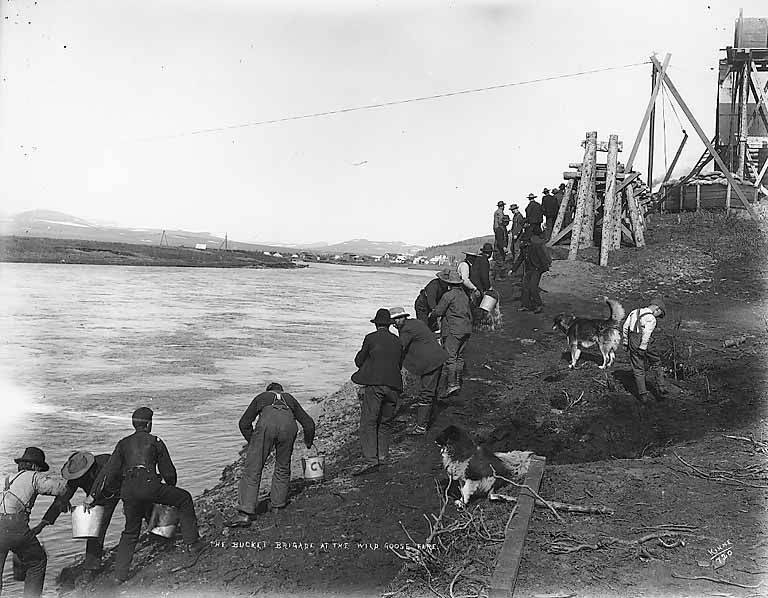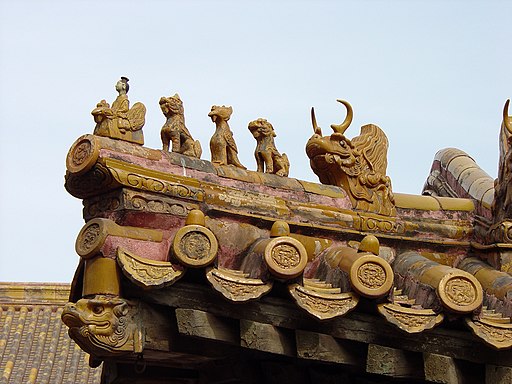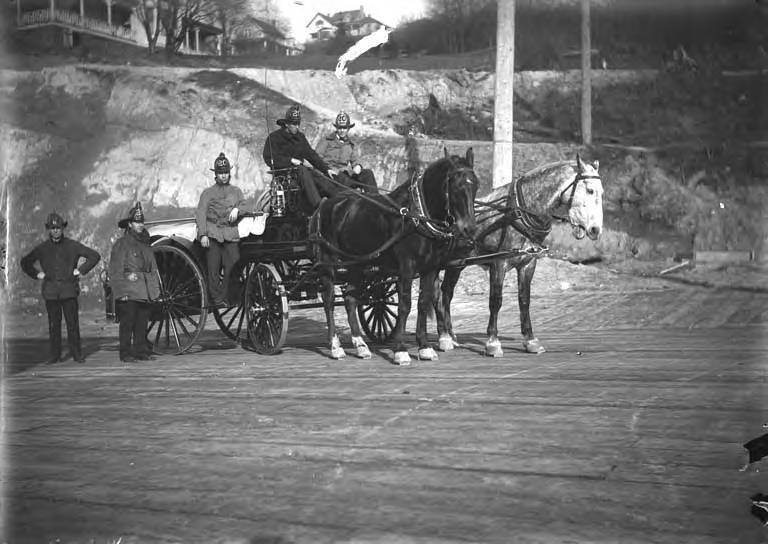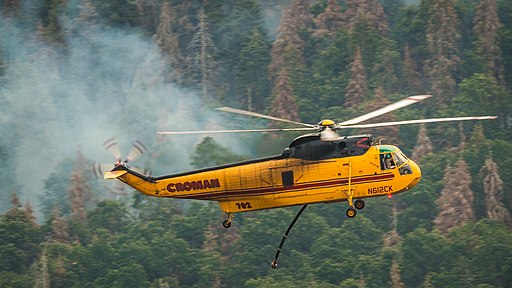Fire is one of the oldest tools used by humans, with archaeological evidence suggesting that it was first used as early as 1.5 million years ago. It has since become an integral part of our daily lives and civilization, for good and bad. With its rise came the need for organized efforts to combat it when it became too dangerous or destructive to handle alone. Thus the long and fascinating history of firefighting began.
Earliest Forms of Firefighting
The use of fire in ancient times dates back to the Stone Age, when it was used for cooking, heating, and lighting. Despite its benefits, early humans were also aware of the risks posed by uncontrolled fires. This gave rise to the concept of firefighting, which was an important skill for early civilizations.

Fighting fire with determination and teamwork: Men of Council, Alaska work together to douse the flames along the Niukluk River, 1907.
Bucket Brigade
One of the earliest forms of firefighting is known as the bucket brigade. It comprises a group of people passing buckets filled with water from one individual to another in a continuous chain to reach a source of water and then throw water onto a fire from afar.
During colonial times in North America, people used bucket brigades until organized firefighting services formed in the mid-1800s.
However, bucket brigades failed to effectively put out large fires as people grew tired after only a short time of working. This meant that they were only effective in fighting small fires that were close to a water source. Despite this limitation, bucket brigades played a significant role in promoting teamwork and collaboration among members of the community during an emergency. This sense of cooperation is still a fundamental aspect of organized firefighting today.
Ancient Rome
The Roman Empire was an expansive civilization that spanned centuries. It’s no surprise that during this time, fires were common in cities like Rome. Fortunately, the Romans devised effective ways of dealing with these fires.
The vigiles, or also called watchmen, led firefighting efforts in Rome. They were responsible for watching out for potential fires in the city by patrolling on foot or riding on horseback. When they spotted a fire, they would sound an alarm and rush to put it out using buckets filled with water or sand they had prepared beforehand. They worked in teams and often had assistance from members of the public who volunteered to help them battle the flames.
Ancient China
The Ming Dynasty marks the beginning of the rich history of firefighting in Ancient China. After the Forbidden City was completed in 1420, lightning caused three main buildings to burn down. Starting from the early Qing Dynasty, the settlers installed anti-lightning devices to stop more disasters from happening. One of these devices was animal-like figures with iron tongues stretched out on the cornices of some halls.
The ancient Chinese had a clever way of fighting fires: a fire extinguisher system that was always ready to use. This system helped stop disasters, especially during the night when it was dark and there was no light from the sun or other sources. The Chinese placed big jars filled with water all around the city in important places near buildings and homes. This way, if a fire started in a certain area, even in the dark, there would be plenty of water nearby to use right away.
In addition to their fire extinguisher system, the ancient Chinese also organized fire brigades. Emperor Kangxi organized these fire brigades in 1673 and equipped them with jitong devices to extinguish fires.
A jitong is a two-pole device used to pump water from a bucket onto a fire, with the larger pole wrapping around part of the smaller one. The operator filled the bucket with water, lifted one end, and squeezed it hard to spray water on the fire.
Imperial Fire Brigade
Emperor Kangxi established the Imperial Fire Brigade, which monitored and maintained jitongs throughout China. Their main purpose was to fight fires and prevent them from spreading throughout cities and villages.

In the lower left is a symbol of protection against fire, a makara, a water-dragon, guards the structure. G41rn8, CC BY-SA 4.0, via Wikimedia Commons
The Great Fire
Early records show that London had its own Fire Brigade set up in 1667 following The Great Fire which devastated much of the city.
By the 18th century, private fire brigades began appearing across Europe. Businesses and individuals who sought greater protection from fires supported these fire brigades. They had a mix of both paid workers and volunteers who would quickly go to any place where there was a reported fire in their area.

The Seattle Fire Department’s brave crew and trusty horse-drawn hose wagon in the 1900s.
As technology advanced during the Industrial Revolution, so did our methods for fighting fires. During this time, firefighters started using pumps powered by steam engines, making it easier for them to get water from rivers to put out fires. This idea led to the formation of professionalized fire departments throughout Europe during this period.
By 19th Century America, increased urbanization meant that dedicated municipal fire departments became commonplace. These organizations often employed full-time staff, including a “fire chief” who acted as the head of department operations and specialist teams focused on investigating causes behind incidents and fighting specific blazes such as forest fires.
The Emergence of Professional Firefighting
During the Middle Ages, many cities in Europe established professional firefighting organizations, often with the help of guilds or other trade organizations. Early firefighters provided their services for a fee as volunteers. They carried basic tools such as buckets and ladders.
In the United States, the first professional fire companies were established in the late 1700s and early 1800s. Insurance companies often funded these early fire departments, which paid a fee to firefighters for their services in fighting fires that threatened insured buildings.
Union Fire Company
The Union Fire Company, founded in 1736 by Benjamin Franklin, was the first organized firefighting society in Philadelphia and the United States. He established the pioneering organization to prevent further damage from rampant fires in the city.
The Union Fire Company consisted of a group of volunteers responsible for assembling at the scene of any fires that occurred to suppress them. They would use buckets filled with water to put out the flames and hooks and ladders to help rescue efforts. This company served as an inspiration for other early firefighting societies across America that formed shortly after.
As the population of the cities grew, so did the need for professional firefighters. By the late 1800s, most major cities in the United States had professional fire departments.
Firefighting in the Modern Era
During the 19th century’s industrial age, rapid growth in cities caused an increase in large-scale fires that hand bucket teams couldn’t handle. So, people developed steam engines specifically for fighting fires.
In 1829, Edmund Armstrong invented a steam-powered engine that enabled firefighters to transport water more easily, quickly, and efficiently than ever before.
This time period saw progress in keeping people safe from fires. Firefighters started to wear uniforms and worked for official departments. Training taught them to respond swiftly to fires and enforce laws to protect citizens from fire damage due to negligence or recklessness.

A helicopter drops water on the Cedar Fire, amidst the devastating tree mortality in the Sequoia National Forest.
By World War II, modern technology had greatly improved methods for controlling fires with aircraft carrying special chemicals. Chemical foam agents began replacing water-based solutions to make firefighting more effective in containing hazardous wildfires. These chemical foam agents effectively prevented secondary fires from combustible liquids like oil or gas.
New technologies like infrared cameras used to detect hot spots helped make fighting blazes faster and safer for personnel on the ground and in aircraft. With modern technology, today’s firefighters have better tools to help them respond to emergencies. This includes things like thermal cameras and special alarms. This makes it safer for people and helps reduce damage to buildings and property during fires or leaks of dangerous materials.
Final Thoughts
Firefighting has evolved over the centuries as a necessary tool to combat and contain destructive forces of nature. With its roots in ancient history, firefighting has become an essential part of our daily lives and civilization. It has taken many forms, from early hunter-gatherer tribes using primitive tools to modern fire departments utilizing advanced technology and firefighters trained in specialized techniques. As long as humans rely on fire for warmth, cooking, and other practical uses, there will always be a need for organized firefighting efforts that can save lives and property from destruction.


